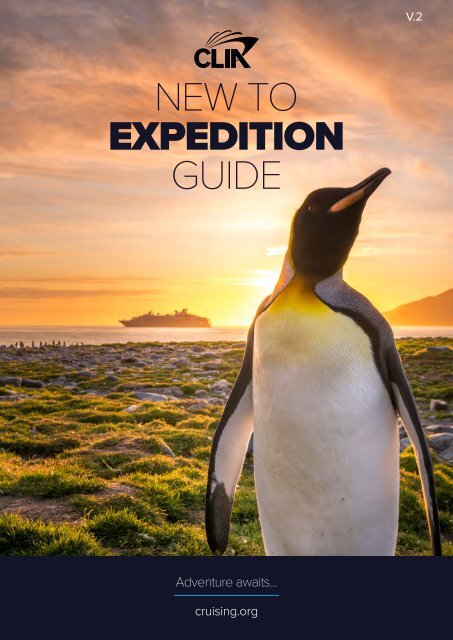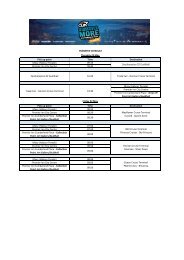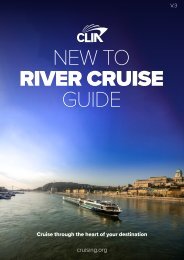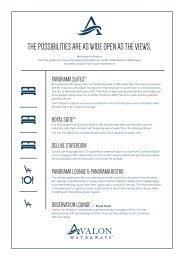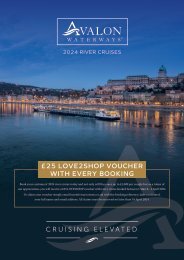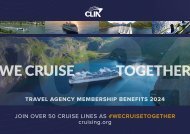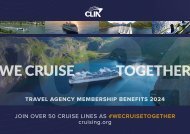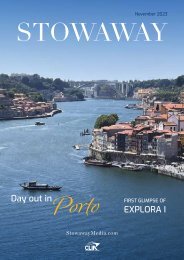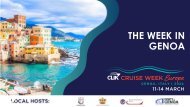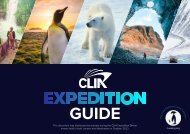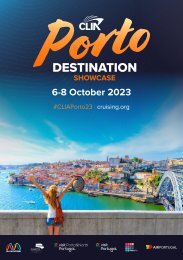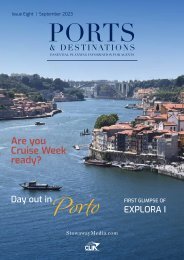New to Cruise Guide_Expedition - web
You also want an ePaper? Increase the reach of your titles
YUMPU automatically turns print PDFs into web optimized ePapers that Google loves.
V.2<br />
CRUISE LINES INTERNATIONAL ASSOCIATION<br />
NEW TO<br />
EXPEDITION<br />
GUIDE<br />
Adventure awaits...<br />
cruising.org<br />
CLIA - NEW TO EXPEDITION CRUISE GUIDE 1
NEW-TO-EXPEDITION CRUISE GUIDE<br />
SECTION CONTENT PAGE<br />
Welcome <strong>to</strong> the first <strong>Expedition</strong> <strong>Guide</strong> from CLIA –<br />
this is a sec<strong>to</strong>r that has grown and developed<br />
significantly over recent years such that we felt now<br />
was the time <strong>to</strong> launch this bespoke <strong>Guide</strong>, just for you.<br />
<strong>Expedition</strong> Cruising has grown as new ships and cruise<br />
lines enter the sec<strong>to</strong>r, as new destinations open up <strong>to</strong><br />
this small ship exploration, and as holidaymakers look<br />
for something different, adventurous and off the beaten<br />
track. They are the ultimate trip for making memories<br />
that last a lifetime, based on the scenery, wildlife, nature,<br />
culture and environment being visited.<br />
Introduction<br />
Onboard<br />
Experiences<br />
An Introduction <strong>to</strong> <strong>Expedition</strong> Cruising 4<br />
<strong>Expedition</strong> style River Cruising 7<br />
A Day in the Life 9<br />
Differences from Classic Ocean Cruising 10<br />
Onboard Experts and Lectures 13<br />
Additional Craft 14<br />
Sustainability 17<br />
Packing List 18<br />
Look out for expedition themed events from CLIA <strong>to</strong> get<br />
even more insights and information!<br />
Andy Harmer<br />
Managing Direc<strong>to</strong>r<br />
CLIA UK & Ireland<br />
CRUISE LINES<br />
INTERNATIONAL<br />
ASSOCIATION<br />
Top Sales Tips for Selling an <strong>Expedition</strong> <strong>Cruise</strong> 20<br />
Antarctica | South Georgia | Falkland Islands | Sub-Antarctic Islands 26<br />
Svalbard (Spitsbergen) 28<br />
Greenland 30<br />
Northwest Passage 32<br />
Northeast Passage 34<br />
Destination<br />
<strong>Guide</strong>s<br />
Russian Far East 36<br />
Iceland / Faroe Islands 38<br />
Alaska & Pacific Northwest 40<br />
Americas (Sea of Cortez, Costa Rica, Panama) 42<br />
Asia (Indonesia, Borneo, Papua <strong>New</strong> Guinea) 44<br />
Kimberley, Australia 46<br />
Galapagos 48<br />
Top Tips 51<br />
<strong>Expedition</strong> Calendar 52<br />
2<br />
CLIA - NEW TO EXPEDITION CRUISE GUIDE<br />
CLIA - NEW TO EXPEDITION CRUISE GUIDE<br />
3
Sea of Cortez<br />
An Introduction <strong>to</strong><br />
<strong>Expedition</strong> Cruising<br />
Intrepid adventurers have never had it so good<br />
when it comes <strong>to</strong> exploring the most inaccessible<br />
regions of the planet by cruise ship. <strong>Expedition</strong><br />
cruising has enjoyed unprecedented growth in the<br />
last few years which has virtually changed this niche<br />
sec<strong>to</strong>r of the cruise industry out of all recognition –<br />
and it shows no sign of running out of steam.<br />
<strong>Cruise</strong> companies are forging ahead with new<br />
ships equipped with state-of-the-art technology,<br />
revolutionary designs and luxurious <strong>to</strong>uches that<br />
could never have been imagined a few years ago.<br />
Each new expeditionary ship ushers in groundbreaking<br />
innovations, from onboard science<br />
labora<strong>to</strong>ries and underwater lounges with viewing<br />
portholes <strong>to</strong> high-tech <strong>to</strong>ys that include drones,<br />
helicopters and mini-submarines. With their sleek<br />
lines and mega-yacht styling, <strong>to</strong>day’s generation<br />
of vessels is a world away from the gritty no-frills<br />
ice-breakers of the past, yet they still have <strong>to</strong>p Polar<br />
Class classifications due <strong>to</strong> strengthened hulls that<br />
enable them <strong>to</strong> withstand <strong>to</strong>ugh icy conditions.<br />
Pioneering technology has also been used <strong>to</strong> equip<br />
ships with environmentally-protective measures<br />
designed <strong>to</strong> cut fuel consumption and reduce<br />
emissions, achieved in some cases by innovative<br />
hull designs or hybrid technology.<br />
Such a transformation has also been reflected<br />
in guest facilities onboard with a new wave of<br />
sophisticated craft that combine hardcore adventure<br />
with luxurious lifestyle. Think panoramic balcony<br />
suites, butler service and haute cuisine served<br />
in multiple upscale dining venues along with fullservice<br />
spas and fitness areas, hot tubs and infinity<br />
pools.<br />
This niche market has also broadened out from<br />
a core of established opera<strong>to</strong>rs <strong>to</strong> new entrants,<br />
including some mainstream lines that have<br />
established their own dedicated expedition arms<br />
running alongside their classic cruise divisions.<br />
Fuelling this has been growing demand among<br />
travellers who are looking for authentic experiences<br />
<strong>to</strong> remote regions on small ships and prepared <strong>to</strong><br />
pay handsomely for the privilege.<br />
While <strong>to</strong>tal passenger numbers are low, as most<br />
ships carry just a few hundred guests, prices are<br />
not with average booking values hovering between<br />
£10,000 and £20,000. Such growth has, in turn,<br />
brought a proliferation of new cold water and<br />
warm water destinations as the rising number of<br />
expeditionary vessels seek out more undiscovered<br />
terri<strong>to</strong>ries <strong>to</strong> explore.<br />
The Polar regions remain the ultimate prize of<br />
expedition cruising, but the range of itineraries<br />
<strong>to</strong> these areas is expanding <strong>to</strong> encompass<br />
nearby destinations such as Iceland, the Faroe<br />
Islands, Norway and Greenland in the Northern<br />
Hemisphere, and <strong>New</strong> Zealand’s Sub-Antarctic<br />
Islands, Cape Horn and Patagonia in the Southern<br />
Hemisphere.<br />
Sailing along the fabled Northwest Passage through<br />
the Canadian Arctic presents one of the ultimate<br />
expeditionary challenges, while the Northeast<br />
Passage along the northern coast of Siberia opens<br />
up a wilderness that for many years was out of<br />
bounds.<br />
However, the rise in adventurous tropical spots has<br />
literally brought expedition cruising in from the cold<br />
with Australia’s Kimberley region and the Galapagos<br />
Islands proving increasingly popular, while emerging<br />
Indonesian archipelagos such as the Spice Islands<br />
and Raja Ampat inject exotic appeal.<br />
It’s a similar s<strong>to</strong>ry for Borneo and Papua <strong>New</strong><br />
Guinea whose fascinating mix of equa<strong>to</strong>rial<br />
rainforests and cultural riches is one of many fac<strong>to</strong>rs<br />
that has turned expeditionary voyages in<strong>to</strong> the<br />
cruise industry’s hot ticket.<br />
Mitchell Falls in outback<br />
Western Australia<br />
4<br />
CLIA - NEW TO EXPEDITION CRUISE GUIDE<br />
CLIA - NEW TO EXPEDITION CRUISE GUIDE<br />
5
<strong>Expedition</strong> style<br />
River Cruising<br />
River cruises are increasingly carving a path<br />
in<strong>to</strong> adventurous terri<strong>to</strong>ry as more remote<br />
waterways open up <strong>to</strong> international travellers.<br />
Asia has the biggest choice of sailings that<br />
venture off the beaten track in<strong>to</strong> isolated<br />
regions where roads are non-existent and<br />
rivers are the key transport artery. Such<br />
sailings have an expeditionary air about<br />
them, giving guests a feeling of exploring<br />
somewhere special where foreigners rarely<br />
venture. It is quite common not <strong>to</strong> see<br />
another <strong>to</strong>urist boat for days at a time, if at all,<br />
and <strong>to</strong> be a source of curiosity for villagers<br />
who may never have encountered Western<br />
travellers before.<br />
Days will be spent peacefully cruising through<br />
deserted pristine wildernesses of lush jungle<br />
or paddy fields perhaps with a spectacular<br />
mountainous backdrop, with s<strong>to</strong>ps at<br />
riverside villages and markets where the most<br />
memorable experiences come from meeting<br />
locals and visiting schools full of wide-eyed<br />
curious youngsters.<br />
The Lower Mekong through Vietnam and<br />
Cambodia combines the metropolitan buzz<br />
of Ho Chi Minh City and Siem Reap with the<br />
cultural appeal of floating markets, village life<br />
and the Unesco-protected temples of Angkor,<br />
while the Upper Mekong, flowing through<br />
Laos in<strong>to</strong> Thailand and China, has a more<br />
remote flavour.<br />
Myanmar’s Irrawaddy River is famous for its<br />
as<strong>to</strong>unding collection of 2,000-plus temples<br />
scattered across the plain at Bagan, while<br />
cruises along the Chindwin River further<br />
north, which stretches up <strong>to</strong> the Indian border,<br />
take guests through remote tribal lands with<br />
a his<strong>to</strong>ry of British colonial rule and Second<br />
World War conflicts.<br />
<strong>Cruise</strong>s in India promise cultural overload,<br />
from the temples and rituals that accompany<br />
Ganges voyages <strong>to</strong> the wildlife of the<br />
Brahmaputra River in Assam where animal<br />
sanctuaries are home <strong>to</strong> endangered tigers<br />
and rare one-horned rhinos.<br />
Wildlife is also the main draw on Amazon<br />
cruises – where the narrower Peruvian<br />
section of this great river is better suited <strong>to</strong><br />
small riverboats that take guests through the<br />
rainforest <strong>to</strong> spot exotic flora and fauna and<br />
visit indigenous tribes.<br />
AmaWaterways<br />
Angkor Wat, Cambodia<br />
6<br />
CLIA - NEW TO EXPEDITION CRUISE GUIDE<br />
CLIA - NEW TO EXPEDITION CRUISE GUIDE<br />
7
A Day in the Life<br />
Unlike traditional voyages, expeditionary sailings –<br />
and especially those <strong>to</strong> the Polar regions – do not<br />
have a set route once ships arrive as they are then<br />
guided by weather / sea conditions and wildlife<br />
sightings that determine how long each vessel<br />
spends at a particular place.<br />
Any sea days enroute <strong>to</strong> the destination tend <strong>to</strong> be<br />
spent attending talks given by the team of onboard<br />
expedition guides and lecturers on relevant <strong>to</strong>pics<br />
that encompass wildlife and natural features of the<br />
region, his<strong>to</strong>ry and culture. Sometimes there will be<br />
film screenings <strong>to</strong>o.<br />
On arrival, days fall in<strong>to</strong> a regular pattern comprising<br />
two or three trip options, with passengers split in<strong>to</strong><br />
small groups which go ashore at alternate times <strong>to</strong><br />
keep numbers low.<br />
Activities can start early with passengers departing<br />
on <strong>to</strong>urs by 7.30am/8am. Some groups may head off<br />
on a hiking expedition, while others may take a trip<br />
in one of the Zodiac boats <strong>to</strong> view the landscape and<br />
wildlife.<br />
If these return by mid-afternoon, there can be a third<br />
option which could be a kayaking <strong>to</strong>ur or snorkelling<br />
trip (in warm water destinations). Days where there<br />
are three different <strong>to</strong>urs can be busy and tiring, with<br />
just an hour between trips in some cases.<br />
Alternatively, on days where there are two trips,<br />
these tend <strong>to</strong> depart a little later – around 9am,<br />
returning for lunch, before setting off for the<br />
afternoon.<br />
Not surprisingly, evenings are low key after such<br />
exertions. There is normally a debriefing session with<br />
expedition leaders before dinner, when they explain<br />
the following day’s schedule.<br />
Dinner becomes the sociable focus of the evening<br />
with shared tables and a chance <strong>to</strong> compare the<br />
day’s experiences with other guests before retiring<br />
<strong>to</strong> the lounge for a night-cap and then bed.<br />
Where there is an early start, trips may return midmorning,<br />
allowing for time <strong>to</strong> relax before an early<br />
lunch. The next outings may be a straight swap,<br />
enabling each group <strong>to</strong> try a different experience <strong>to</strong><br />
earlier.<br />
Antarctica<br />
8<br />
CLIA - NEW TO EXPEDITION CRUISE GUIDE<br />
CLIA - NEW TO EXPEDITION CRUISE GUIDE<br />
9
Differences from classic<br />
ocean cruising<br />
Size is everything – mainstream cruise ships carry<br />
an average of around 3,000 passengers, with<br />
the largest leviathans capable of holding nearly<br />
7,000 passengers. The biggest expedition vessels<br />
tend <strong>to</strong> be around 500 passengers as this is the<br />
maximum limit permitted for ships wanting <strong>to</strong> land<br />
passengers in Antarctica. Most sea-going ships<br />
take 200 <strong>to</strong> 300 pax, while rustic riverboats may<br />
take around 30 or less.<br />
Getting shipshape – while classic cruise ships<br />
have a roll-call of restaurants, bars and leisure<br />
facilities, expedition vessels are built <strong>to</strong> navigate<br />
areas inaccessible <strong>to</strong> larger ships and are<br />
equipped with Zodiac boats for shore landings,<br />
kayaks and, in some cases, high-tech gizmos,<br />
including helicopters and submarines. Some ships<br />
also have science centres where guests can assist<br />
on-board experts with scientific research.<br />
Scenic Eclipse<br />
Onboard entertainment – cabaret shows, live bands and nightclubs keep the beat going in<strong>to</strong> the early hours<br />
on regular cruise vessels whereas lectures, film screenings (often relating <strong>to</strong> the destinations visited) and<br />
quizzes are the evening diversions on expedition voyages, often followed by an early night with many guests<br />
retiring by around 9/10pm.<br />
Full days of activity – on classic cruises sea days tend <strong>to</strong> revolve around pool and leisure activities while<br />
port days offer a chance <strong>to</strong> visit local attractions on excursions. On expedition cruises, the theme is more<br />
about education and adventure. Early starts are commonplace, with explorations ashore for hikes or wildlife<br />
viewing, Zodiac boat rides, kayaking outings or snorkelling trips.<br />
Black tie v hiking boots – regular cruises offer lots of chances <strong>to</strong> don your party gear. Don’t even bother<br />
packing it for expeditionary sailings where the emphasis in Polar regions is on warm layers and waterproofs,<br />
while in warmer climes essentials are swimming gear and sturdy footwear for hikes, along with decent<br />
mosqui<strong>to</strong> repellent.<br />
French Polynesia<br />
10<br />
CLIA - NEW TO EXPEDITION CRUISE GUIDE<br />
CLIA - NEW TO EXPEDITION CRUISE GUIDE<br />
11
Onboard Experts<br />
and Lectures<br />
FELICITY ASTON MBE<br />
Explorer, Scientist, Speaker and Author<br />
The teams of experts that work aboard expeditionary<br />
ships help <strong>to</strong> bring each destination <strong>to</strong> life for<br />
passengers and are one of this sec<strong>to</strong>r’s most<br />
defining features.<br />
Guests can expect <strong>to</strong> be accompanied by expedition<br />
leaders whenever they leave the ship, whether it<br />
involves going ashore or exploring coastal waters<br />
in kayaks or one of the Zodiac boats. Team leaders<br />
have in-depth knowledge and experience of the<br />
local surroundings and bring their own specialisms<br />
<strong>to</strong>o as qualified naturalists, marine biologists or<br />
ornithologists. But whatever their level of expertise,<br />
they all possess passion and knowledge they want<br />
<strong>to</strong> share with guests.<br />
With more expedition ships now equipped with<br />
science labora<strong>to</strong>ries, guests can also watch them at<br />
work or even take part in research themselves.<br />
Where there are indigenous settlements, cultural<br />
guides will help <strong>to</strong> lead the way with information and<br />
arrange visits <strong>to</strong> meet local tribes while acting as<br />
interpreters.<br />
For activities such as kayaking or mountain hiking,<br />
qualified leaders will be on-hand <strong>to</strong> assist and guide<br />
groups, while pho<strong>to</strong>graphy experts accompany<br />
many voyages <strong>to</strong> help guests perfect their picturetaking<br />
skills.<br />
This is reinforced by an onboard programme of talks<br />
on various <strong>to</strong>pics relevant <strong>to</strong> each destination.<br />
In Polar regions, for example, there may be<br />
glaciologists who will talk about glacial deposits and<br />
erosive features, or his<strong>to</strong>rians who will recall the<br />
heritage of the whaling industry and recount s<strong>to</strong>ries<br />
of famous explorers associated with the terri<strong>to</strong>ries.<br />
Felicity As<strong>to</strong>n is the first and only woman<br />
in the world <strong>to</strong> ski across Antarctica alone.<br />
The 1,744km, 59-day journey completed in January<br />
2012 also made her the first person in the world<br />
<strong>to</strong> traverse the continent purely by muscle power<br />
without the aid of kites or machines, earning<br />
her a place in the Guinness Book of World<br />
Records. In 2015 she was awarded the Queen’s<br />
Polar Medal for services in Antarctica and was<br />
appointed MBE for services <strong>to</strong> Polar Exploration.<br />
www.felicityas<strong>to</strong>n.com<br />
Speaking at the CLIA<br />
Conference, 2019<br />
Such a flow of knowledge means expedition ships<br />
become a floating classroom where, in addition<br />
<strong>to</strong> daily briefings, there are opportunities <strong>to</strong> speak<br />
<strong>to</strong> the experts individually. When ships are sailing<br />
through areas of notable interest, guides will often<br />
give a running commentary over the ship tannoy<br />
about the area, pointing out particular features. If<br />
there is an unexpected wildlife event, sightings of<br />
whales or other sealife, one of the experts may give<br />
an ad hoc commentary.<br />
When ships are sailing in Polar regions, there will<br />
often be scientists onboard conducting their own<br />
research who will deliver lectures during the voyage.<br />
12<br />
CLIA - NEW TO EXPEDITION CRUISE GUIDE<br />
CLIA - NEW TO EXPEDITION CRUISE GUIDE<br />
13
Additional Craft<br />
Helicopters, mini-submarines and ROVs are some<br />
of the new sophisticated twists that are helping <strong>to</strong><br />
transform expedition cruising.<br />
Silversea <strong>Expedition</strong>s<br />
Such ships have traditionally carried small rigid<br />
inflatable boats (RIBS), such as Zodiacs, <strong>to</strong> ferry<br />
passengers <strong>to</strong> landing points or take them<br />
on wildlife-spotting trips and forays along the<br />
shoreline.<br />
As guests have become increasingly active,<br />
more vessels are equipped with fleets of kayaks,<br />
enabling passengers <strong>to</strong> paddle away on trips<br />
designed <strong>to</strong> bring them closer <strong>to</strong> the natural<br />
surroundings.<br />
But a new wave of modern and more luxurious<br />
expeditionary craft is upping the ante with evermore<br />
adventurous ways <strong>to</strong> explore remote terrain,<br />
especially in Antarctica.<br />
Scenic<br />
Small submarines are another high-tech addition on the latest generation ships. Holding between two and<br />
six passengers, they can reach depths of up <strong>to</strong> 1,000ft, and some are equipped with video recorders <strong>to</strong> give<br />
passengers a lasting memen<strong>to</strong> of their dive.<br />
Such one-off experiences are not cheap, though guests looking for less expensive options can opt for other<br />
new alternatives such as snowshoeing, stand-up paddle-boarding or e-biking.<br />
Another option is <strong>to</strong> sit back and admire panoramic views from the observation decks. However, some ships<br />
have brought a new dimension <strong>to</strong> this with hydraulic viewing platforms that fold out from the bow, while<br />
others have underwater lounges where guests can watch passing marine views through large portholes.<br />
Some ships are equipped with ROVs (Remotely<br />
Operated Vehicles). These are robotic submarines<br />
that can explore <strong>to</strong> depths of 1,000ft and are<br />
tethered <strong>to</strong> their “mother boat” from where they<br />
are remotely operated by a crew member. Highlytuned<br />
controls mean an ROV can be manoeuvred<br />
with the utmost precision, enabling its highdefinition<br />
video camera <strong>to</strong> project underwater<br />
shots back <strong>to</strong> the ship for passengers <strong>to</strong> view on a<br />
large screen.<br />
Helicopters are also starting <strong>to</strong> appear on modern<br />
expedition vessels with some carrying not one,<br />
but two such craft that can carry around six<br />
passengers on sightseeing flights, heli-skiing and<br />
heli-hiking trips.<br />
Aurora <strong>Expedition</strong>s<br />
14<br />
CLIA - NEW TO EXPEDITION CRUISE GUIDE<br />
CLIA - NEW TO EXPEDITION CRUISE GUIDE<br />
15
Sustainability<br />
<strong>Expedition</strong> cruise lines are at the forefront of a<br />
concerted campaign <strong>to</strong> reduce their carbon footprint<br />
and protect the pristine wildernesses they sail<br />
through.<br />
The relatively small size of expedition ships already<br />
means their impact on the local environment is less<br />
than their larger ocean-going counterparts, but<br />
revolutionary technical innovations have made the<br />
latest generation of expedition vessels more fuel<br />
efficient than ever before.<br />
Pioneering new hull designs and hybrid technology<br />
that reduces emissions by using liquefied natural<br />
gas (LNG) and battery power are being increasingly<br />
employed on ships. Meanwhile, dynamic propulsion<br />
systems that replace the need <strong>to</strong> drop anchor, thus<br />
avoiding potential damage <strong>to</strong> the seabed, are also<br />
becoming more widespread.<br />
<strong>Expedition</strong>ary lines have led the way in introducing<br />
environmentally-friendly practices governing<br />
everything from waste disposal and banning singleuse<br />
plastics <strong>to</strong> sourcing ethical food producers,<br />
utilising biodegradable cleaning materials and<br />
recycling wherever possible.<br />
<strong>Expedition</strong> crews and <strong>to</strong>ur leaders are also<br />
passionate about safeguarding natural surroundings,<br />
educating passengers and promoting a strong<br />
conservation message. Trips ashore are strictly<br />
controlled with limits on group numbers, ensuring<br />
that guests follow designated paths and maintain a<br />
safe distance from wildlife.<br />
In Antarctica – which has some of the strictest<br />
regulations governing cruise ship visits <strong>to</strong> protect<br />
its unique eco-systems – passengers have <strong>to</strong><br />
disinfect their boots before and after shore trips<br />
<strong>to</strong> prevent cross-contamination, while taking food<br />
ashore is prohibited. The largest ship permitted <strong>to</strong><br />
land passengers on the so-called White Continent<br />
can carry a maximum of 500 guests and only 100 of<br />
them are allowed ashore at any one time.<br />
In the Galapagos Islands off the coast of Ecuador,<br />
the national park authorities decree that ships<br />
cannot exceed 100 passengers and must follow a<br />
pre-arranged itinerary <strong>to</strong> specific islands that locks in<br />
the date and time window they are permitted <strong>to</strong> visit.<br />
Guests are not allowed <strong>to</strong> go ashore without guides<br />
and must keep a distance of at least two metres from<br />
wildlife.<br />
As expeditionary ships visit such remote areas,<br />
they also play a vital role in scientific research,<br />
often carrying scientists <strong>to</strong> collect critical data<br />
and gather field samples. With more vessels now<br />
equipped with labora<strong>to</strong>ries, experts have increased<br />
scope <strong>to</strong> analyse their findings and there are also<br />
opportunities for guests <strong>to</strong> get involved and attend<br />
lectures and workshops.<br />
Additionally, some cruise companies organise<br />
volun<strong>to</strong>urism activities that guests can participate<br />
in. These include beach clean-ups, releasing<br />
newly-hatched baby turtles, tracking cetaceans<br />
for research projects and planting trees as part of<br />
reforestation efforts. On sailings which s<strong>to</strong>p at local<br />
communities, guests are asked <strong>to</strong> bring pens, pencils<br />
and other stationery <strong>to</strong> give <strong>to</strong> local children on<br />
school visits.<br />
16<br />
CLIA - NEW TO EXPEDITION CRUISE GUIDE<br />
CLIA - NEW TO EXPEDITION CRUISE GUIDE<br />
17
Packing List<br />
Casual, comfortable and practical are the main considerations when packing for an expedition cruise.<br />
Sailing <strong>to</strong> such isolated places means the chances of replacing forgotten items or s<strong>to</strong>cking up on supplies<br />
are virtually non-existent, so it’s worth taking extra back-up. Polar destinations command a different checklist<br />
of items than tropical spots, but for both life onboard is casual with a relaxed dress code. Wherever<br />
you are headed, cameras are a must, preferably with a good zoom lens, a large capacity memory card and<br />
extra batteries as cold conditions tend <strong>to</strong> drain them more quickly. And don’t forget your binoculars.<br />
Feeling hot, hot, hot<br />
Tropical attire revolves around lightweight<br />
clothing and swimwear, though long-sleeve<br />
<strong>to</strong>ps and flowing dresses or loose trousers can<br />
protect against insects, particularly mosqui<strong>to</strong>es.<br />
Life in the freezer<br />
Rain ponchos or lightweight, quick drying<br />
jackets are also handy in a sudden downpour.<br />
A key ingredient is a warm, windproof parka-type<br />
jacket. Several companies provide these as part of<br />
the cruise, so it’s worth checking in advance.<br />
Many also provide waterproof boots, which are<br />
essential for exploring and negotiating shallow<br />
water when going ashore in Zodiac boats.<br />
Windproof and waterproof trousers are crucial,<br />
along with warm, waterproof gloves – in both<br />
instances ski clothing is ideal.<br />
The secret is <strong>to</strong> dress in layers with T-shirts and<br />
fleeces, leggings and thermal underwear.<br />
It’s also worth donning silk gloves as a first layer<br />
under thicker gloves because these make it easier<br />
<strong>to</strong> operate camera equipment and will still help <strong>to</strong><br />
keep hands warm. Remember <strong>to</strong> bring a hat and<br />
neck-warmer <strong>to</strong>o.<br />
UV protection sunglasses and sunscreen are<br />
essential due <strong>to</strong> the snowy glare, along with a<br />
rucksack <strong>to</strong> keep items in when ashore.<br />
Don’t forget swimming costumes as more ships<br />
now have hot tubs and/or pools, and there’s always<br />
a chance for brave souls <strong>to</strong> take the polar plunge in<br />
the freezing waters.<br />
Footwear varies between sandals or slipon<br />
beach shoes which are useful for beach<br />
landings, though more sturdy walking shoes or<br />
boots are needed for hikes.<br />
Sunscreen, insect repellent containing deet<br />
and cream <strong>to</strong> treat insect bites or stings are<br />
essential, along with UV sunglasses and a hat.<br />
If snorkelling trips are on the agenda<br />
(particularly in areas such as the Galapagos),<br />
it’s worth taking an underwater camera <strong>to</strong><br />
record marine encounters.<br />
18<br />
CLIA - NEW TO EXPEDITION CRUISE GUIDE<br />
CLIA - NEW TO EXPEDITION CRUISE GUIDE<br />
19
Top Sales Tips for Selling an <strong>Expedition</strong> <strong>Cruise</strong><br />
1.<br />
2.<br />
3.<br />
4.<br />
5.<br />
6.<br />
Know your polar bears<br />
from your penguins<br />
Gen up on the Arctic (the so-called<br />
Kingdom of the Polar Bear) and<br />
Antarctica (where penguins roost in<br />
colonies thousands strong). These<br />
icy wildernesses may seem similar,<br />
but in many respects are a world<br />
apart.<br />
Hot water v cold water<br />
<strong>Expedition</strong> cruises aren’t all about<br />
Polar regions. There are tropical<br />
adventurous spots in Asia, Latin<br />
America and the Kimberley region<br />
of Australia, while the growth of<br />
this sec<strong>to</strong>r means the choice of<br />
destinations is increasing.<br />
Soft adventure or<br />
hardcore expedition<br />
Some companies offer a gentle<br />
taste of exploration that just<br />
scratches the surface, while<br />
others pack in a full programme of<br />
immersive activities that requires<br />
a decent degree of fitness and<br />
stamina <strong>to</strong>o.<br />
No-frills <strong>to</strong> opulent luxury<br />
No-nonsense Russian ice-breakers<br />
are big on hardcore adventure, but<br />
come with fewer home-comforts,<br />
while a new generation of plush<br />
expedition ships or “yachts”<br />
combine exploration with gourmet<br />
dining, spas and butler service.<br />
Potential expedition<br />
cruisers<br />
These could be adventurers<br />
who enjoy going off the beaten<br />
track; who may never have<br />
cruised before and would never<br />
countenance big-ship sailings;<br />
and solo travellers who will enjoy<br />
the camaraderie of small-ship<br />
explorations.<br />
Small is beautiful<br />
Passengers are in their hundreds<br />
rather than thousands. The smaller<br />
the ship, the more personalised the<br />
experience and the more chances<br />
guests get <strong>to</strong> explore, especially<br />
in Antarctica where the maximum<br />
ship size permitted for landings<br />
is 500 pax and only 100 pax are<br />
allowed ashore at any one time.<br />
20<br />
CLIA - NEW TO EXPEDITION CRUISE GUIDE<br />
CLIA - NEW TO EXPEDITION CRUISE GUIDE<br />
21
Top Sales Tips for Selling an <strong>Expedition</strong> <strong>Cruise</strong><br />
7.<br />
8.<br />
9.<br />
10.<br />
11.<br />
12.<br />
Paying the price<br />
Value for money<br />
Timing is everything<br />
A taste of adventure<br />
Tapping in<strong>to</strong> a theme<br />
Plant the seeds<br />
<strong>Expedition</strong> cruises carry a high<br />
price tag, but if cost is an issue,<br />
search for lines that include more<br />
in the overall price, and research<br />
departure dates at the start or<br />
end of the season when rates are<br />
generally lower.<br />
Highlight the bucket-list fac<strong>to</strong>r of<br />
expeditionary cruises and paint<br />
an evocative picture of the mindblowing<br />
experiences guests will<br />
enjoy, sharing your own first-hand<br />
knowledge where applicable.<br />
Breaking down the <strong>to</strong>tal cost in<strong>to</strong><br />
a daily rate also helps <strong>to</strong> underline<br />
the value.<br />
Research the best seasons<br />
for expeditionary destinations;<br />
the type of wildlife and natural<br />
wonders that guests can expect<br />
<strong>to</strong> see and when; local festivals<br />
and celebrations, plus weather<br />
conditions.<br />
Examine the range and scope<br />
of activities offered in different<br />
destinations; how active or<br />
innovative they are; how much of<br />
a flavour they give of the region.<br />
Look at how this relates <strong>to</strong> each<br />
client’s wish-list.<br />
Some designated sailings have<br />
visiting experts on <strong>to</strong>pics such as<br />
pho<strong>to</strong>graphy, wildlife or his<strong>to</strong>ry that<br />
will help guests <strong>to</strong> get the most out<br />
of each destination with lectures<br />
and visits ashore.<br />
Suggest an expeditionary sailing<br />
as a special holiday. Perhaps <strong>to</strong><br />
mark a birthday, anniversary or<br />
as a family treat with children/<br />
grandchildren <strong>to</strong> somewhere like<br />
the Galapagos Islands.<br />
22<br />
CLIA - NEW TO EXPEDITION CRUISE GUIDE<br />
CLIA - NEW TO EXPEDITION CRUISE GUIDE<br />
23
Destination <strong>Guide</strong>s<br />
Aldabra, Seychelles<br />
24<br />
CLIA - NEW TO EXPEDITION CRUISE GUIDE<br />
CLIA - NEW TO EXPEDITION CRUISE GUIDE<br />
25
Cold Water<br />
What You Will See...<br />
Antarctica:<br />
• Whales, seabirds and thousands of penguins<br />
• Snow-covered landscapes that remain the most untamed, majestic and<br />
unspoilt on the planet.<br />
• The picturesque Lemaire Channel<br />
• Bergs the size of houses in Iceberg Alley (the Antarctic Sound)<br />
South Georgia:<br />
• Dramatic Alpine-style landscape<br />
• King penguins, fur and elephant seals, whales<br />
Falkland Islands:<br />
• King penguin and macaroni penguin rookeries<br />
• Battlefields from the conflict between the UK and Argentina in 1982<br />
Antarctica<br />
South Georgia<br />
Falkland Islands<br />
Sub-Antarctic Islands<br />
Sub-Antarctic Islands:<br />
• Rugged landscapes of mountains, forests, fjords and rocky cliffs<br />
• Rookeries of thousands of penguins including king, yellow-eyed and<br />
crested varieties<br />
• Ten of the world’s albatross species<br />
• Sea lions, fur and southern elephant seals, whales<br />
Useful tip: Only ships with 500 passengers or fewer can make landings in<br />
Antarctica. Choose a vessel with 200 guests or fewer for the opportunity<br />
(weather permitting) <strong>to</strong> visit two landing sites a day.<br />
Key embarkation ports:<br />
• Antarctica, South Georgia and the Falkland Islands: Ushuaia in Argentina<br />
and Punta Arenas in Chile<br />
• Sub-Antarctic Islands: Invercargill, Christchurch, Dunedin in <strong>New</strong> Zealand<br />
and Hobart in Tasmania<br />
Best time <strong>to</strong> go:<br />
<strong>Cruise</strong> ships are in the Southern Ocean between November and March. This<br />
is the Antarctic summer but chilly with average temperatures from minus 10C<br />
<strong>to</strong> plus 10C. December and January are best for whale, iceberg and penguin<br />
chick sightings. Shorter cruises focus on the Antarctic Peninsula, longer ones<br />
add South Georgia and the Falkland Islands.<br />
The Sub-Antarctic Islands, a collection of five island groups that lie <strong>to</strong> the south<br />
and east of <strong>New</strong> Zealand in the Southern Ocean, may also be slotted in<strong>to</strong> long<br />
Antarctica voyages or as the focus of shorter sailings, with most departing<br />
between November and February.<br />
Antarctica<br />
Falkland<br />
Islands<br />
South<br />
Georgia<br />
26<br />
CLIA - NEW TO EXPEDITION CRUISE GUIDE<br />
CLIA - NEW TO EXPEDITION CRUISE GUIDE<br />
27
Cold Water<br />
What You Will See...<br />
Svalbard:<br />
• Arctic wildlife including polar bears, whales, walrus, Arctic foxes and seals<br />
• Kittiwakes, guillemots, puffins and many other seabirds<br />
• Deep fjords and vast glaciers<br />
Useful tip: Be flexible. The itinerary will depend on weather and ice<br />
conditions, while trips ashore are possible only once the expedition team is<br />
sure an area is free of polar bears.<br />
Svalbard (Spitsbergen)<br />
Key embarkation port:<br />
Longyearbyen in Spitsbergen; Tromsø in Norway<br />
Best time <strong>to</strong> go:<br />
<strong>Cruise</strong> ships are in Svalbard between June and August,<br />
very occasionally nudging in<strong>to</strong> September.<br />
Early in the season is good for polar bear spotting as they are out on the ice<br />
looking for immature seal pups.<br />
Svalbard<br />
Norway<br />
28<br />
CLIA - NEW TO EXPEDITION CRUISE GUIDE<br />
CLIA - NEW TO EXPEDITION CRUISE GUIDE<br />
29
Cold Water<br />
What You Will See...<br />
Greenland:<br />
• Inuit villages and west coast settlements including Ilulissat, Sisimiut,<br />
Qeqertarsuaq and Uummannaq and the capital Nuuk<br />
• Scoresbysund – the world’s largest fjord, plus icebergs, glaciers and active<br />
volcanoes<br />
• Potential polar bear sightings plus excellent whale-watching with narwhals,<br />
beluga and blue whales<br />
• Eqip Sermia Glacier<br />
Useful tip: Budget for a <strong>to</strong>ur <strong>to</strong> the mouth of the Ilulissat icefjord, where<br />
massive bergs jostle <strong>to</strong> get in<strong>to</strong> the open sea.<br />
Greenland<br />
Key embarkation port:<br />
Nuuk or Kangerlussuaq in Greenland; Reykjavik and Akureyri in Iceland;<br />
Longyearbyen in Spitsbergen; Tromso in Norway<br />
Best time <strong>to</strong> go:<br />
<strong>Expedition</strong> ships are in Greenland between May and Oc<strong>to</strong>ber, when the ice<br />
has receded, the days are long and the wildlife has come alive after the icy<br />
winter.<br />
The peak time is from mid-July <strong>to</strong> mid-August, though September is also<br />
noted as one of the best months <strong>to</strong> sail here as the Northern Lights can<br />
be spotted.<br />
Greenland<br />
Iceland<br />
30<br />
CLIA - NEW TO EXPEDITION CRUISE GUIDE<br />
CLIA - NEW TO EXPEDITION CRUISE GUIDE<br />
31
Cold Water<br />
What You Will See...<br />
Northwest Passage<br />
• Beechey Island, the last known s<strong>to</strong>p of the failed 1845 Franklin <strong>Expedition</strong><br />
<strong>to</strong> find the Northwest Passage<br />
• Inuit settlements<br />
• Narrow Peel Sound<br />
• Arctic wildlife including whales, seals, polar bears and musk ox<br />
• Deep fjords, icebergs and glaciers<br />
Useful tip: If time is at a premium, certain cruise lines offer shortened<br />
"passage" crossings between Greenland and the Canadian Arctic.<br />
Northwest Passage<br />
Key embarkation port:<br />
Kangerlussuaq in Greenland; Reykjavik in Iceland; Nome in Alaska<br />
Best time <strong>to</strong> go:<br />
Ships journey through the Northwest Passage in early or late summer as<br />
they reposition between Antarctica and the Arctic.<br />
32<br />
CLIA - NEW TO EXPEDITION CRUISE GUIDE<br />
CLIA - NEW TO EXPEDITION CRUISE GUIDE<br />
33
Cold Water<br />
What You Will See...<br />
Northeast Passage<br />
• One of the most isolated parts of the world, dotted with small communities<br />
and uninhabited islands and bays<br />
• Polar bears, whales, walrus, reindeer and thousands of sea birds<br />
• Highlights including bird-watching in Kangerlussuaq and hikes across the<br />
tundra in Cape Florens<br />
Useful tip: The combination of limited capacity and huge demand means<br />
you need <strong>to</strong> be quick <strong>to</strong> secure a cabin on these sailings.<br />
Northeast Passage<br />
Key embarkation port:<br />
Nome in Alaska; Tromsø in<br />
Norway; Anadyr in Russia<br />
Best time <strong>to</strong> go:<br />
<strong>Cruise</strong>s are in late August and<br />
early September. Only three ships<br />
will make this journey, across<br />
the <strong>to</strong>p of Russia, in the next two<br />
years.<br />
34<br />
CLIA - NEW TO EXPEDITION CRUISE GUIDE<br />
CLIA - NEW TO EXPEDITION CRUISE GUIDE<br />
35
Russian Far East<br />
Cold Water<br />
Russian Far East<br />
What You Will See...<br />
• Volcanoes and brown bears on Russia’s Kamchatka Peninsula, a remote<br />
spot that spends most of the year covered in snow<br />
• Seals, sea lions and seabirds including kittiwakes, puffins, cormorants and<br />
tufted ducks<br />
• A former Soviet gulag on Atlatsova Island where female political prisoners<br />
were held<br />
• The Aleutian Island of Attu, site of the only World War 2 land battle fought<br />
on US soil<br />
Useful tip: Expect the unexpected. Planned itineraries can change due <strong>to</strong><br />
weather conditions and local bureaucracy.<br />
Otaru, Japan<br />
Key embarkation port:<br />
Otaru in Japan; Seward and Nome in Alaska;<br />
Petropavlovsk in Russia<br />
Best time <strong>to</strong> go:<br />
<strong>Cruise</strong>s operate between June and September.<br />
36<br />
CLIA - NEW TO EXPEDITION CRUISE GUIDE<br />
CLIA - NEW TO EXPEDITION CRUISE GUIDE<br />
37
Cold Water<br />
What You Will See...<br />
Iceland / Faroe Islands<br />
• Spectacular scenery and rich marine life that includes seals, dolphins,<br />
humpback, minke and blue whales, plus numerous other species<br />
• Iceland’s “Golden Circle” trio of natural wonders comprising the Gullfoss<br />
Waterfalls, Thingvellir National Park and Geyser Geothermal Area<br />
• Iceland’s capital, Reykjavik, and the Blue Lagoon geothermal springs<br />
• Faroe Islands’ capital and former Viking trading hub Torshavn<br />
Useful tip: For cruises starting or ending in Reykjavik, add on a few days in<br />
the city <strong>to</strong> allow time <strong>to</strong> explore it properly and visit the Blue Lagoon.<br />
Iceland / Faroe Islands<br />
Key embarkation port:<br />
Reykjavik in Iceland; Bergen and Tromsø in Norway;<br />
Longyearbyen in Spitsbergen<br />
Iceland<br />
Best time <strong>to</strong> go:<br />
Faroe<br />
Islands<br />
The cruise season runs from May <strong>to</strong> September, though June<br />
and July are popular for Midnight Sun sailings when there is<br />
24-hour daylight.<br />
38<br />
CLIA - NEW TO EXPEDITION CRUISE GUIDE<br />
CLIA - NEW TO EXPEDITION CRUISE GUIDE<br />
39
Cold Water<br />
What You Will See...<br />
Alaska & Pacific Northwest<br />
Alaska & Pacific Northwest<br />
• Breathtaking mountain ranges, vast forests, glaciers and thousands of<br />
miles of pristine wilderness<br />
• Numerous species of bears and whales, plus dolphins, colonies of sea<br />
lions, spawning salmon, eagles and caribou<br />
• His<strong>to</strong>ric “Gold Rush” era <strong>to</strong>wns, fishing villages, Russian heritage and<br />
indigenous communities<br />
• Inside Passage, Glacier Bay, Tracy Arm Fjord, San Juan Islands, Aleutian<br />
Islands and Haida Gwaii Islands<br />
Useful tip: Be prepared for unpredictable conditions as Alaska is famous<br />
for “liquid sunshine”, especially in the summer months when wildlife is more<br />
prevalent, so be sure <strong>to</strong> pack layers and waterproofs.<br />
Key embarkation port:<br />
Vancouver in Canada; Seattle, Seward, Ketchikan, Sitka<br />
and Juneau in USA<br />
Best time <strong>to</strong> go:<br />
Alaska (USA)<br />
The season runs from May <strong>to</strong> September.<br />
Seward<br />
Sitka<br />
Ketchikan<br />
Juneau<br />
Canada<br />
Vancoover<br />
Seattle<br />
USA<br />
40<br />
CLIA - NEW TO EXPEDITION CRUISE GUIDE<br />
CLIA - NEW TO EXPEDITION CRUISE GUIDE<br />
41
Warm Water<br />
What You Will See...<br />
Americas<br />
• Outstanding marine life in the Sea of Cortez, off Mexico’s Baja Peninsula.<br />
Dubbed the “aquarium of the world” there are hundreds of species of<br />
whales, turtles, manta rays, sea lions and dolphins<br />
• Panama Canal – the 50-mile waterway connecting the Atlantic and Pacific<br />
oceans<br />
• Costa Rica’s lush jungle, hot springs, cloud forest and abundant tropical<br />
wildlife<br />
• Pacific and Caribbean coasts of Costa Rica and Panama, though<br />
expeditionary sailings largely explore the Pacific side.<br />
Useful tip: While cruises focus on the varied marine life (an underwater<br />
camera is a must), hiking boots are needed for treks across the rocky,<br />
mountainous terrain.<br />
Americas<br />
(Sea of Cortez, Costa Rica, Panama)<br />
Key embarkation ports<br />
• Sea of Cortez: San Carlos, La Paz, Cabo San Lucas in<br />
Baja California, Mexico; Los Angeles and San Diego in<br />
USA; Colon in Panama<br />
Sea of Cortez<br />
• Costa Rica/Panama: San Jose in Costa Rica; Panama<br />
City in Panama<br />
Best time <strong>to</strong> go:<br />
November <strong>to</strong> April is peak season for the Sea of Cortez as<br />
this is when whales arrive <strong>to</strong> breed.<br />
For Costa Rica and Panama, December <strong>to</strong> April are the most<br />
favourable months.<br />
Costa Rica<br />
Panama<br />
42<br />
CLIA - NEW TO EXPEDITION CRUISE GUIDE<br />
CLIA - NEW TO EXPEDITION CRUISE GUIDE<br />
43
Warm Water<br />
What You Will See...<br />
Asia<br />
• Indonesia’s Spice Islands, Komodo National Park and the Raja Ampat<br />
Islands<br />
• Uninhabited islands, smoking volcanoes, bountiful flora and fauna,<br />
spectacular diving, indigenous tribes<br />
• Rich wildlife with Komodo dragons in Indonesia, orang-utans in Borneo,<br />
whale sharks in Papua <strong>New</strong> Guinea<br />
• World War 2 his<strong>to</strong>ry of Papua <strong>New</strong> Guinea, particularly the Battle of Milne<br />
Bay, and his<strong>to</strong>ry of Dutch traders and Portuguese explorers in Indonesia<br />
Useful tip: Indonesia’s most popular archipelagos are spread across a large<br />
area, so choose which one you want <strong>to</strong> visit as they cannot be combined in<br />
one sailing.<br />
Asia<br />
(Indonesia, Borneo, Papua <strong>New</strong> Guinea)<br />
Key embarkation ports:<br />
Bali, Biak, Ambon, Sorong in Indonesia; Darwin, Cairns in<br />
Australia; Honiara in the Solomon Islands; Colombo,<br />
Sri Lanka; Singapore<br />
Best time <strong>to</strong> go:<br />
Warm, tropical conditions mean cruises can operate yearround,<br />
though the dry season from April <strong>to</strong> Oc<strong>to</strong>ber is<br />
generally regarded as the best time <strong>to</strong> visit this part of Asia.<br />
Indonesia<br />
Borneo<br />
Papua <strong>New</strong><br />
Guinea<br />
44<br />
CLIA - NEW TO EXPEDITION CRUISE GUIDE<br />
CLIA - NEW TO EXPEDITION CRUISE GUIDE<br />
45
Warm Water<br />
What You Will See...<br />
Kimberley, Australia<br />
• The vast Montgomery Reef rising up out of the sea as the huge tide<br />
recedes<br />
• The powerful Horizontal Falls In Talbot Bay<br />
• Ancient Wandjina and Gwion Gwion rock art<br />
• The twin King George River and 80-metre-high Falls<br />
• Salties (crocodiles), sea turtles, kingfishers, egrets, sea eagles, whales.<br />
• The beehive-like Bungle Bungle Mountain range<br />
Useful tip: Grab a few nights <strong>to</strong> relax and swim at one of Broome’s Cable<br />
Beach resorts; once on the cruise, swimming is a no-no due <strong>to</strong> the salties.<br />
Kimberley, Australia<br />
Key embarkation ports:<br />
Broome and Darwin<br />
Best time <strong>to</strong> go:<br />
<strong>Cruise</strong>s operate between April and Oc<strong>to</strong>ber. The waterfalls<br />
are most spectacular in April and May, but there might be<br />
some rainy days. June, July and August are most popular for<br />
warm days and blue skies.<br />
Kimberley<br />
Broome<br />
Darwin<br />
Australia<br />
46<br />
CLIA - NEW TO EXPEDITION CRUISE GUIDE<br />
CLIA - NEW TO EXPEDITION CRUISE GUIDE<br />
47
Warm Water<br />
What You Will See...<br />
Galápagos<br />
• An abundance of animals with no fear of humans, that have adapted <strong>to</strong> the<br />
different island environments in which they live. Favourites include:<br />
giant <strong>to</strong>r<strong>to</strong>ises, marine iguanas, sea lions and lava lizards that<br />
communicate with each other via a sequence of press-ups<br />
• A "post office" on Floreana Island, where passengers can leave postcards<br />
and pick up ones that others have left <strong>to</strong> be delivered<br />
• The Charles Darwin Research Centre in Puer<strong>to</strong> Ayora, the capital, on Santa<br />
Cruz Island<br />
Useful tip: Pack wet shoes as landings are made by inflatable Zodiacs and<br />
often require stepping in<strong>to</strong> the sea or on <strong>to</strong> rocks.<br />
Galápagos<br />
Celebrity Flora<br />
Key embarkation ports:<br />
Baltra and San Cris<strong>to</strong>bal, Ecuador<br />
Best time <strong>to</strong> go:<br />
<strong>Cruise</strong>s operate year-round. January <strong>to</strong> May is hot and<br />
maybe a bit rainy. June <strong>to</strong> December is dry and a bit cooler.<br />
Galápagos Islands<br />
48<br />
CLIA - NEW TO EXPEDITION CRUISE GUIDE<br />
CLIA - NEW TO EXPEDITION CRUISE GUIDE<br />
49
Top Tips<br />
• Be flexible. <strong>Expedition</strong> itineraries change with the<br />
weather, ice and landing conditions<br />
• Wildlife sightings are likely but never guaranteed<br />
• Wrap up and get out on deck as much as possible<br />
<strong>to</strong> be sure of the best views and wildlife sightings<br />
• Dress in layers for the polar regions; wear light<br />
cot<strong>to</strong>n clothes for warmer climates. A good<br />
camera and binoculars are musts<br />
• Tread lightly in Antarctica, where just stepping on<br />
the fragile vegetation will leave scars for years<br />
• Keep a distance from wildlife and never try <strong>to</strong><br />
<strong>to</strong>uch animals, no matter how tame they seem<br />
• Passengers need <strong>to</strong> be fairly nimble <strong>to</strong> climb in<br />
and out of the inflatable Zodiacs used for landings<br />
in remote spots<br />
50<br />
CLIA - NEW TO EXPEDITION CRUISE GUIDE<br />
CLIA - NEW TO EXPEDITION CRUISE GUIDE<br />
51
<strong>Expedition</strong> Calendar<br />
Antarctica/South<br />
Georgia/Falkland<br />
Islands/Sub-<br />
Antarctic Islands<br />
Americas:<br />
Sea of Cortez<br />
Americas:<br />
Costa Rica<br />
& Panama<br />
Asia Galápagos Arctic: Svalbard Russian Far East Iceland<br />
Alaska & Pacific<br />
Northwest<br />
Greenland<br />
Kimberley,<br />
Australia<br />
Northwest<br />
Passage<br />
Northeast<br />
Passage<br />
April<br />
May<br />
June<br />
July<br />
DRYER<br />
PEAK<br />
PEAK<br />
PEAK<br />
August<br />
September<br />
Oc<strong>to</strong>ber<br />
COOLER & DRYER<br />
November<br />
December<br />
January<br />
February<br />
March<br />
Warm Water<br />
Cold Water<br />
52<br />
CLIA - NEW TO EXPEDITION CRUISE GUIDE<br />
CLIA - NEW TO EXPEDITION CRUISE GUIDE<br />
53
CRUISE LINES<br />
INTERNATIONAL<br />
ASSOCIATION<br />
STAY CONNECTED<br />
With CLIA membership you are part of the world’s<br />
largest cruise community, allowing you <strong>to</strong> keep up <strong>to</strong><br />
date with the latest industry news through exclusive<br />
online resources and events, created exclusively for<br />
CLIA travel agent members.<br />
Hear from industry experts in the CLIA <strong>Cruise</strong> Podcasts<br />
and Webcasts, learn about sec<strong>to</strong>r changes and put your<br />
questions forward in the CLIA Live Webinars and join<br />
our Virtual Showcase events where engaging speakers<br />
share sec<strong>to</strong>r updates and inspiring sales advice<br />
alongside the chance for virtual networking.<br />
CLIA also provides a host of exclusive online resources,<br />
providing agents with current industry insight,<br />
trends and statistics.<br />
BE PART OF THE CRUISE COMMUNITY<br />
VISIT CRUISING.ORG<br />
@CLIAUK CLIAEurope CLIAEuro CLIAEurope<br />
54<br />
CRUISING.ORG<br />
CLIA - NEW TO EXPEDITION CRUISE GUIDE


